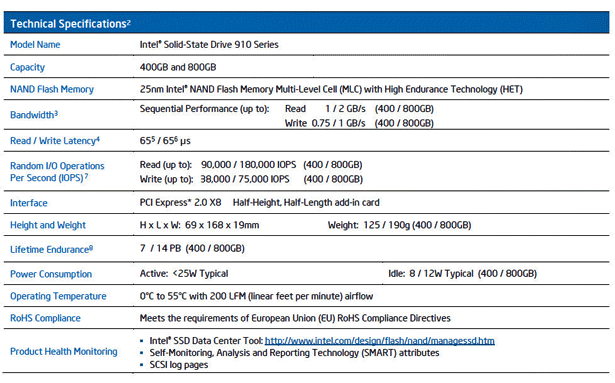Intel Announces PCI Express SSD 910 Product Family
Product Positioning & Design
Intel's vision for the 910 sees the SSD finding a home in multiple high-end business / enterprise scenarios, particularly those where high write speeds and/or random data reads are a significant percentage of the average workload. If you've paid attention to some of the other companies making PCI-Express-based storage solutions, however, you'll note that Intel's quoted 2GB/s reads / 1GB/s writes for an 800GB drive are well below what companies like OCZ have claimed for their own enterprise-class products. According to OCZ, the Z-Drive R4 is capable of both reading and writing at 2.8GB/s. Why the difference, particularly when both products use Intel NAND?

The difference lies in Intel's High Endurance Technology (HET). HET debuted with the 710 family and it's a major part of the 910 series as well. According to Intel, HET is the reason why the 910 family can sustain such high write rates; the company's technical documentation cites a lifetime endurance of 14PB (petabytes) for the 800GB drive.

HET improves NAND reliability in two basic ways. The first approach (detailed on the left-hand side of the image above) is that Intel cherry picks the best of its MLC NAND Flash for use in these drives. The benefit there is simple and straightforward -- by using the best chips it can build, Intel starts with a product that supports an inherently larger number of program/erase (P/E) cycles.

The right-hand side of the diagram is more complex. To put it simply, Intel has deliberately chosen to spend more time charging each cell in order to minimize wear and tear. A longer program time trades performance for endurance, which is part of why the sequential write speed on the Intel 910 is so much lower than that of the RevoDrive R4. Another prominent piece of the puzzle is the amount of time data is retained on the drive. Intel's 320 series has a one year retention rate, which means that an SSD left unpowered for 12 months will still have data on it. Because the 710 and 910 are both enterprise products and intended for operation in environments where they'll be powered up virtually 24/7, this long retention period is less necessary. By lowering the retention period to just 3 months, Intel can extend what's known as the NAND's read margin and the overall life of the drive.
We'll have more information on the Intel SSD 910, including performance data, when Intel ships samples out in the not-too-distant future. Current MSRP is expected to be $1929 for the 400GB drive and $3859 for the 800GB drive.

The difference lies in Intel's High Endurance Technology (HET). HET debuted with the 710 family and it's a major part of the 910 series as well. According to Intel, HET is the reason why the 910 family can sustain such high write rates; the company's technical documentation cites a lifetime endurance of 14PB (petabytes) for the 800GB drive.

HET improves NAND reliability in two basic ways. The first approach (detailed on the left-hand side of the image above) is that Intel cherry picks the best of its MLC NAND Flash for use in these drives. The benefit there is simple and straightforward -- by using the best chips it can build, Intel starts with a product that supports an inherently larger number of program/erase (P/E) cycles.

The right-hand side of the diagram is more complex. To put it simply, Intel has deliberately chosen to spend more time charging each cell in order to minimize wear and tear. A longer program time trades performance for endurance, which is part of why the sequential write speed on the Intel 910 is so much lower than that of the RevoDrive R4. Another prominent piece of the puzzle is the amount of time data is retained on the drive. Intel's 320 series has a one year retention rate, which means that an SSD left unpowered for 12 months will still have data on it. Because the 710 and 910 are both enterprise products and intended for operation in environments where they'll be powered up virtually 24/7, this long retention period is less necessary. By lowering the retention period to just 3 months, Intel can extend what's known as the NAND's read margin and the overall life of the drive.
We'll have more information on the Intel SSD 910, including performance data, when Intel ships samples out in the not-too-distant future. Current MSRP is expected to be $1929 for the 400GB drive and $3859 for the 800GB drive.






